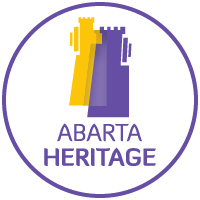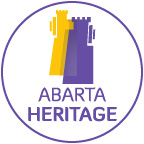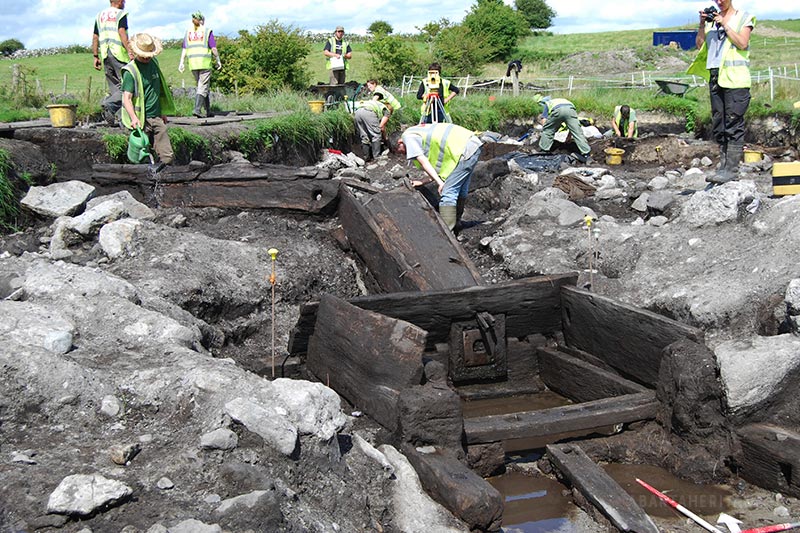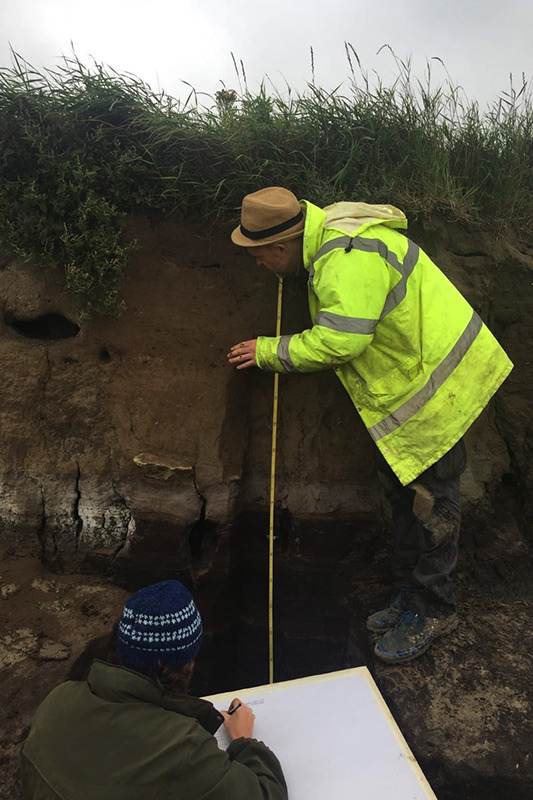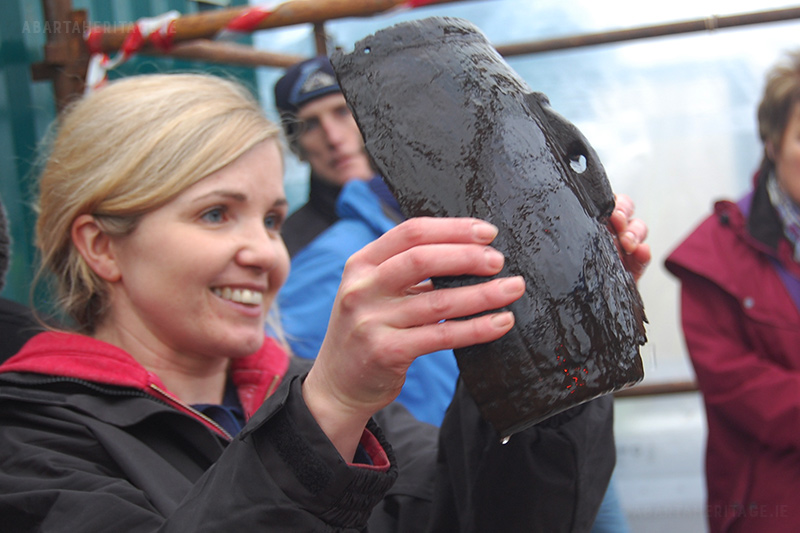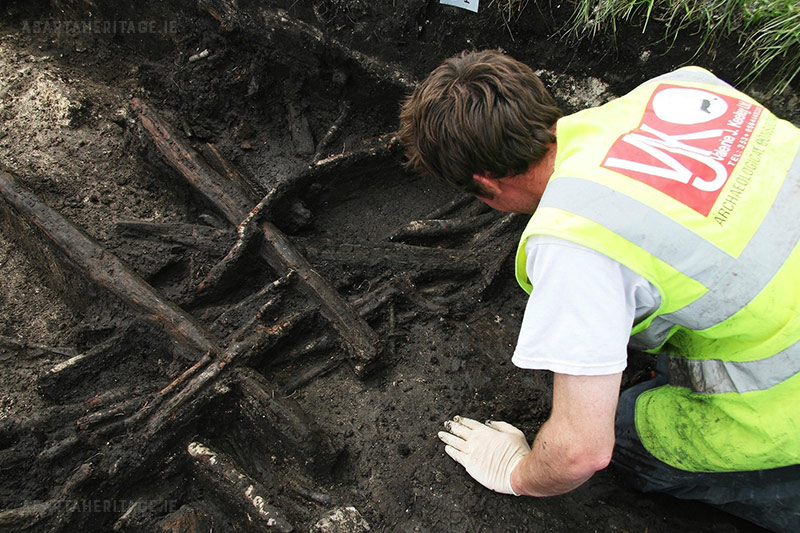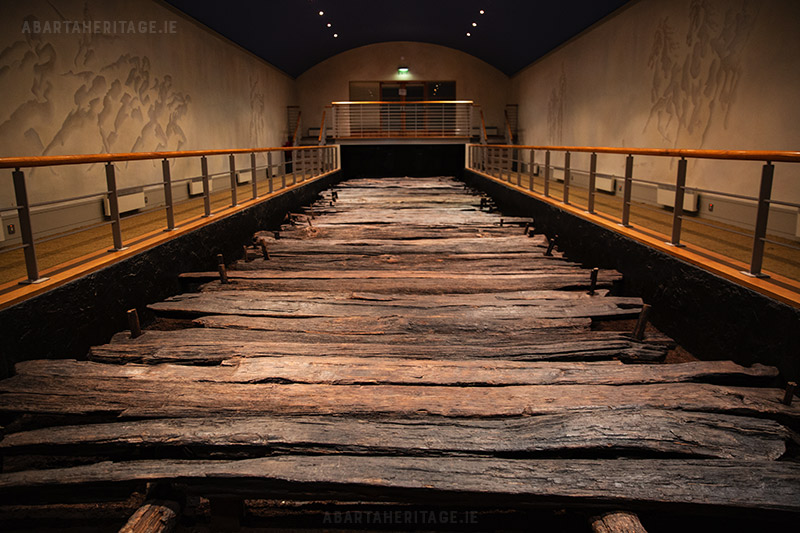Cathy Moore & Dr Ben Gearey discuss Ireland’s wetland archaeology in Amplify Archaeology Podcast Episode 20
From ancient trackways to enigmatic bog bodies, the archaeology of Ireland’s bogs is truly remarkable. But as the industrial peat harvesters fall silent, a new threat appears. Is time finally running out for Ireland’s iconic wetland archaeology? Amplify Archaeology Podcast Episode 20
Bogs and wetlands are one of the most iconic, and characteristically Irish, landscapes. Almost 1/6th of the country is covered by bog, and it is particularly significant in the midlands. Bogs have long served a variety of functions to past and present societies, from places to gather resources like fuel, rushes and reeds or to hunt. They also have a liminal aspect, forming boundaries and dangerous places that were, and often still sadly are, treacherous to the unwary and unfortunate. They are also places of community effort, meitheal, with real intangible cultural heritage all of their own. They have inspired artists, writers and poets for centuries.
Archaeological sites in wetlands vary from wooden trackways, platforms and bridges, to fish traps and fulachta fiadh. One of the defining characteristics of wetland sites is the high quality preservation of organic remains, including human remains as we see so poignantly in the case of ‘bog bodies’. In a sense, the bogs also act as environmental time capsules, as they preserve important palaeoenvironmental material such as botanical and animal remains, and microfossils like pollen. The process of wetland archaeology allows us to investigate and reconstruct past people’s landscapes, culture, and lives in sometimes astonishing detail.
Since the mid-20th century, the increasing industrialisation of peat harvesting has created employment and prosperity for many communities, though it has led to the loss of innumerable archaeological monuments, and the bogs themselves drained and scoured into great brown deserts. Now the immense harvesters are beginning to be silenced and stilled, the bogs are to be transformed once more, some will be ‘rehabilitated’ or ‘rewetted’, others will be planted with windfarms to generate another form of power. These changes will pose more challenges to what is left of the important archaeological and cultural heritage, and it is no exaggeration to say this may be our last chance to identify, record and understand many of these wetland archaeology sites.
In this episode of Amplify Archaeology Podcast, Neil was joined for a Zoom chat with Cathy Moore and Dr. Ben Gearey. Cathy is a highly experienced wetland archaeologist and wooden finds specialist who has excavated remarkable sites such as the trackway complex Edercloon in County Longford, and Drumclay Crannog in County Fermanagh, as well as numerous others including co-directing the excavation of a beautifully preserved watermill at Kilbegly in County Roscommon with Neil. Ben is a Lecturer in Environmental Archaeology, in the Department of Archaeology at University College Cork, Ireland. He has a range of research interests, with a particular focus on the archaeological and palaeoenvironmental records of peatlands.
AMPLIFY ARCHAEOLOGY PODCAST
AMPLIFY ARCHAEOLOGY PODCAST
Title: Wetland Archaeology
Duration: 54 mins.
Summary:
From bog bodies to ancient trackways, the archaeology of Ireland’s bogs is truly remarkable and famous around the world. But it has faced dire threat from peat extraction. Now the harvesters fall silent, another challenge looms. Is time running out for our wetland archaeology?
Episode 20 Wetland Archaeology – Show Notes
- Ben is part of the WetFutures Project – a transdisciplinary approach to wetland heritage in the Netherlands, United Kingdom and Ireland. You can find out more on the project website.
- Both Ben and Cathy are involved in the exciting Pallasboy Project, that seeks to explore the creative process involved in the crafting of prehistoric wooden artefacts beginning with the ‘Pallasboy Vessel’, an Iron Age wooden artefact discovered in Toar Bog, Westmeath. You can find out more on the project website.
- You can read about Bord na Móna’s decision to end peat harvesting in the Green News.
- You can also read more about their policy to ‘rehabilitate’ or ‘rewet’ the bogs on the Bord na Móna website.
- It was an early medieval penannular brooch (rather than a ringpin) that was discovered in the ashes of a fire, by a couple in 2010 in County Kerry. You can read the account in The Irish Times, also in the Irish Examiner.
- You can find out more about the Kingship and Sacrifice exhibition on the National Museum of Ireland website (please note, the webpage has images of human remains).
- The National Museum of Ireland also has an overview of their Bog Bodies Research Project (please note, the webpage has images of human remains).
- Wherever possible I try to link to Irish bookshops rather than the online giants, but as both Cathy and Ben indicated there aren’t many recent publications on Irish wetland archaeology and those that there were are either out of print, or down to the last copy or two. There appears to be a rare copy of the Bog Body of Tumbeagh available from Mayo Books.
- I’ve only managed to find one copy of The Mill at Kilbegly by myself (Neil Jackman) with Cathy Moore and Colin Rynne. It’s listed as available in Alan Hanna’s bookshop, Dublin.
- However thanks to Transport Infrastructure Ireland an overview of the excavation at Kilbegly has been made available free to download on the Digital Repository of Ireland.
- You can also find an overview of Cathy’s remarkable excavations at the trackway complex at Edercloon on the Digital Repository of Ireland.
- The important report: ‘A Review of Archaeological Survey and Mitigation Policy Relating to Bord na Móna Peatlands Since 1990′ prepared by Dr Benjamin Gearey, Dr Nóra Bermingham, Caitríona Moore and Professor Robert Van de Noort is available on the National Monuments Service website.
- You can hear more from Cathy in this great interview on the Broad Leaf Podcast.
- Fin Dwyer of the excellent Irish History Podcast has a really interesting miniseries on one of the most remarkable bog bodies – hear the Road to Old Croghan here.
- Finally, you can hear the story of a community that was originally founded on Bord na Móna works at Lough Boora in County Offaly, with our free Kilcormac Heritage Trail audio guide.
Amplify Archaeology Podcast
During this podcast series we will meet some of Ireland’s archaeologists to discuss the key periods, places and people that tell the story of Ireland, and we’ll gain new insights into the practice and techniques of modern Irish archaeology. This is the twentieth instalment of Amplify Archaeology, previous episodes have featured a miniseries on Newgrange and the Winter Solstice, discussions on excavations at Kilkenny Castle, the Rock of Cashel and Glendalough. We’ve also looked at Ogham, Digital Heritage, Conflict Archaeology, Living History, the Beaker People, History of Food, Passage Tombs, Castles, Mesolithic Ireland and more!
I’d love some feedback, so please do leave a comment below – and if you have any questions about Irish archaeology please do let me know, we can try to answer them in forthcoming episodes. Finally if you enjoyed this podcast I’d be really grateful if you could leave us a review on iTunes, or please share it and tell your friends.
The podcast is an Abarta Heritage production. Due to the ongoing COVID pandemic it was recorded over Zoom with Neil Jackman (the interviewer) Cathy Moore and Dr. Ben Gearey. We are really grateful to Cathy and Ben for their generosity and insights.
….’Our pioneers keep striking
Inwards and downwards,
Every layer they strip
Seems camped on before.
The bogholes might be Atlantic seepage.
The wet centre is bottomless.’
Amplify Archaeology Podcast is also available on
Dig into more stories with Amplify Archaeology Podcast
